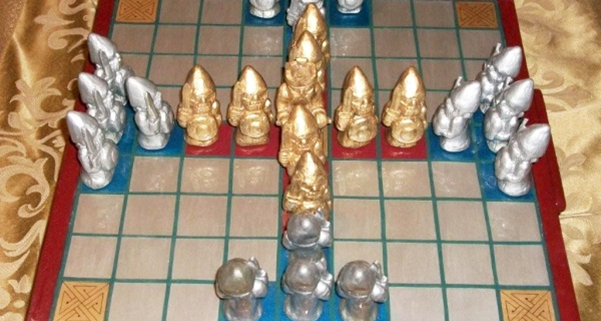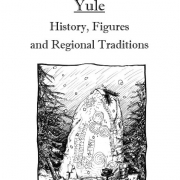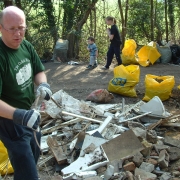Tafl: The Game of the Gods
By Mark Puryear
The game of Tafl, “Tables,” or Hnefatafl, “King’s Tables,” is an ancient pastime that was played by our ancestors as far back as 400 AD, until it was superseded by chess around 1000 A.D. Archaeologists have discovered several boards all over Northern Europe ranging from 7×7 to 19×19 squares with the center and four corner squares almost always decorated. Pieces found are often warriors armed and ready for combat, standing or on horseback, with the majestic king sitting on his throne, prepared to escape the invading hordes. They could also be simple shapes, made of glass, antler, walrus bone, ivory, amber, horse teeth, knuckle bones, or clay. The knuckle bones of sheep were common, and may have a relation to the word Hnefatafl, which is literally translated from the Icelandic as “Fist-Tables.”
In the earliest age, the Æsir gathered in the realm of Iðavöllr to set the stage for creation. There they set up temples and altars for their worship and fashioned forges, treasures, and tools, with which they would build the worlds. In their leisure they “played merrily with Tafl” (Voluspa 8) within their dwellings, which leads us to believe that it was the first game ever invented by our beloved deities. In this sense, this forerunner of chess should be viewed as holy by all who worship the Gods and Goddesses of the North. It allows us to partake in the divine recreation, valued by our exalted progenitors long before they had created and populated Miðgarðr. Of course, this is from a mythic viewpoint, as an integral part of our lore, but no matter how you interpret these tales, one thing is certain – Tafl is the sacred game of the Gods.
In consideration of this, there is an interesting tradition concerning the actual game played in Ásgarðr and how this relates to modern technology. In the Fornalfarsögur it is described as being made of gold and that it “plays by itself, when someone challenges it.” For some reason, it seems that this particular set is lost, for after Ragnarökr “once again, the wondrous game of Tafl is found in the grass, that which was owned in time’s morning by a divine prince, and Fjölnir-Óðinn’s family” (Völuspá 62). In our world today the idea of chess or even some online Tafl games that can play by themselves is almost considered primitive in terms of technological advancement. It is here used as a symbol of the age of peace – when the Gods could no longer engage in such leisurely pursuits this time had ended, but they will be able to do so again when the renewal comes, after the great conflagration.
We can say that, in a religious context, the playing of such games is trivial and meaningless, however we can preclude that our ancestors did not see it that way. Although idleness would have been rare in any agricultural society – definitely not as common as it is today – when it was permissible, it was cherished. At sacred festivals it was often mandated that no work was to be performed. It is likely that an importation division of these events, called the “leikr” (Old Norse word for “playtime”, “game-time”) was valued as much as the blot. Often the games, dances, song, etc. of the “leikr” were seeped in symbology connected to the holy day being celebrated. For instance, at Yule the Posterli hunt took place where an individual or an effigy was chased by the folk to mimic the Wild Hunt honored at this time. The Posterli being a variant of the Túnriður that Óðinn and the other Gods pursue and cleanse the air of in the Ásgarðsreið (Hávamál 157). So here the chase, as a game, corresponds to an important mythic event and at the festival where it is celebrated.
So, if this is the case, what is the symbolism of Tafl? Like chess, it is a miniature recreation of battle, some say of a Viking raid, but this is purely conjecture. It is likely that the idea was for warriors to keep their minds sharp while not in the midst of combat, and so the game would have been played at any holy day. Remember it as a symbol of the age of peace? Our ancestors knew full well that peace is maintained with the blood of those willing to fight for it, so such imagery is fitting. If we were to relate the game to any one particular celebration, this would be the Sigurblót, “The Victory Blót,” held on “Summer Day” (May 1st or Beltaine) as described in Ynglingasaga ch.8. That such warrior displays were practiced by our ancestors as a part of the leikr can be seen in Tacitus’ Germania (ch.24):
“They only have one kind of public spectacle, which is exhibited in every company. Young men, who make it their diversion, dance naked amidst drawn swords and presented spears. Practice has conferred skill at this exercise, and skill has given grace; but they do not exhibit for hire or gain: the only reward of this pastime, though a hazardous one, is the pleasure of the spectators.”
The Scotch and Irish peoples played Tafl as well, preferring 7×7 squared boards. In Scotland it was known as “Ard-Ri”, whereas in Ireland it was called “Brandubh” and “Fitchneall.” The Welsh called it “Tawlbyrd” and may have used dice in their version, which was played on an 11×11 board. The Anglo-Saxons used the largest, 19×19 playing area, which required a lot of pieces to be played, for drawings have been left behind describing how the board was set up. The Finns called their game “Tablut” (a variation of ‘Tafl’) and used a 9×9 board. The number 9 is not only considered holy in our faith, but this version would seem the most fun and balanced. The rules for play are pretty much pieced together from those collected by Swedish botanist Carl von Linne in his record of Tablut in Lapland, which was played as late as 1732. This is combined with observations of board designs, which adds to the game in several ways. The reconstructed rules are as follows below.
Learning and playing Tafl can be a valid part of our religious experience, as we connect to our Gods and ancestors in enjoying their pastime. In the lore it was even played the most celebrated of Teutonic families, that of Jarl, as we see in Rígsthula 40 where his sons “swam and played Tafl.” As Odinists today we can incorporate Tafl into our festivals, enjoying the company of friends in a friendly game, or raising the ante by establishing formal tournaments with prizes and titles. However we choose to do this, we can certainly agree that this game is an important part of our heritage, and should be of our cultural revival as well.
Tafl Rules
The following rules are based upon the 9×9 board and number of pieces played with on such a board. They can be expanded for larger versions, but I have found that this one works quite well.
- The game begins with the assignment of sides – defenders and attackers. The defenders consist of eight pawns and one king. The king sits on the center ‘throne’ and is surrounded by his pawns on the board. There are sixteen attackers, all pawns, set up around the edge of the board. The defenders go first and sides are alternated after each game.
- All pieces move vertically or horizontally, never diagonally, like a rook moves in chess. Pieces may move as many spaces as possible, but may not ‘jump’ other pieces.
- A pawn is captured by being surrounded or flanked on two adjacent squares in the vertical or horizontal position. A piece may move between two flanking opponent pieces without being captured.
- The king cannot be used to capture pieces.
- The center and four corner squares are called ‘thrones’, for only the king may rest upon them. Other pieces may cross over the center throne, but never stop on it.
- Thrones are considered pieces for the purpose of capturing another piece, but only when the king does not sit upon them. If a piece, including the king, rests on a square adjacent to the throne, it can be captured as if the throne itself were an opponent’s piece.
- The attackers win if they capture the king. The king is usually captured by surrounding him on all four sides, or in any way keeping him from being able to move. A more difficult variant allows for the king to be captured with the standard flanking method used to capture a pawn (i.e. the king is surrounded on only two adjacent squares). The defenders win if the king makes it from the center throne to one of the four corner thrones.










Thank you for this post, I absolutely love it. There isn’t much that makes me happier than getting to know my ancestors. Time to work on making my own 9 x 9 board with stone, wood, seashell, &/or clay pieces, to be played during the holy days. Reposting this 🙂